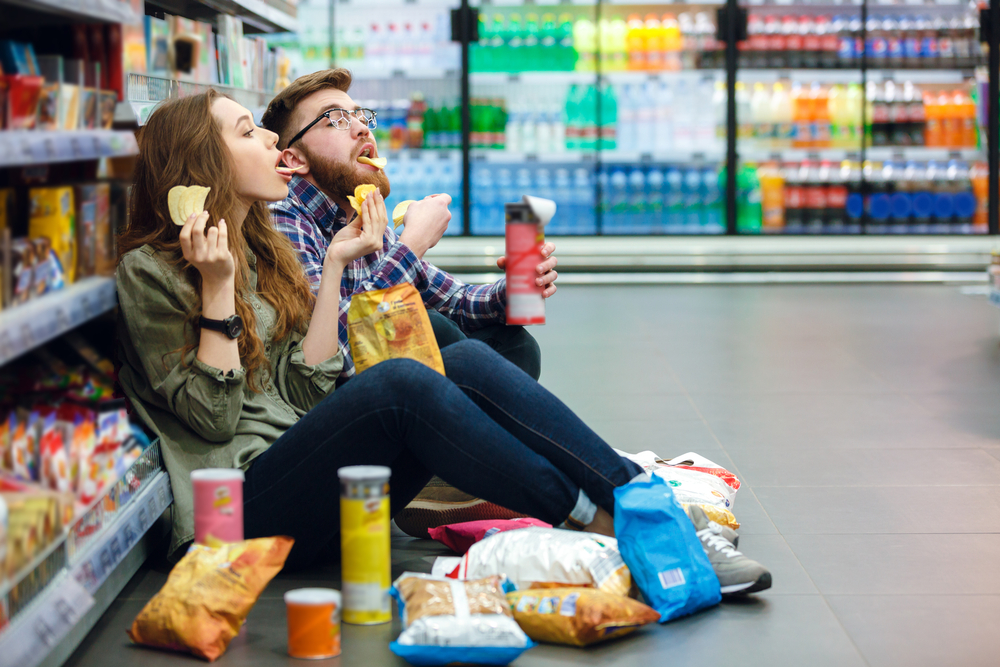Do you have those days where you feel ravenous? You could eat and eat, yet nothing really satisfies you? You’ve probably wondered how to stop snacking but feel like you have no willpower.
We all go through these “snacky” moments. It’s hard to control cravings and stop snacking, especially at night and after dinner. Or maybe you’re an afternoon boredom snacker—working from home, you find yourself raiding the fridge when the mid-day slump hits.
No matter when your cravings hit, you probably want to find out how to stop snacking and get your cravings under control. There are a few steps you can take to get your diet on track.

Key Nutrients that Fuel Our Bodies and Regulate Hunger
Our blood sugar goes up and down throughout the day, depending on activities, energy levels, hydration levels, and of course, the foods we eat. So even if our diet is low in refined sugar, we may still experience ups and downs regularly.
Most foods contain a mixture of carbohydrates, fats, and protein. These are the primary nutrients that foods contain that help us function and give us energy. When we eat, our body breaks down the foods into their essential components. Carbohydrates turn into energy, protein builds muscle and helps organ function, and fats are essential for our cell function and hormones. We need to get a balance of these components for our bodies to run.
Carbohydrates
Carbohydrates are sugars and starches. They break down into glucose (blood sugar), and these items will affect our blood sugar levels throughout the day. Carbohydrates are not bad for us—they give us energy and help us feel satisfied. However, those who have gone on a low-carb or no-carb diet know that we might start to crave them pretty significantly when our body is low on carbs.
Carbohydrates are found in grains, fruits, some dairy products, as well as vegetables. Some veggies are higher in carbohydrates—starchy vegetables like potatoes or corn will be higher in carbohydrates than green leafy vegetables.
Protein
Our bodies break protein down into amino acids. These components help our bodies build and use muscle, help our organ systems function, and keep our hormone levels healthy. Protein can be found in many sources, although we may think of it as coming from animal products. There are many plant-based proteins as well.
Protein can be found in vegetables, nuts, seeds, and beans. Meat, dairy, and eggs are traditional sources of protein too. Protein digestion happens in the stomach and small intestine and requires more work to break down.
Fat
Fat has a bad reputation that it really doesn’t deserve. We need fat to keep our cells healthy. The fatty acids that we consume help our hormones, nervous system, and more. We must get enough fat in our diets or we’ll feel hungry. If we crave certain foods like avocados or peanut butter, it may be due to a lack of fat in our diet.
We find fats in plant oils and animal products. Eggs and butter are two common sources of fats. Olive oils, nuts, coconut, avocado, and some seeds are also good sources of healthy fats.
Our bodies are amazingly adept at breaking down all the foods we consume and turning them into these usable components. But we have to consider what we’re offering our body. What are we eating to support our bodily functions, and what are we consuming that’s making our body work overtime?
Typically, we’ll break down carbohydrates first, which give us energy and help us get that “boost” that most of us want. Carbohydrates often curb our snack cravings in the short term. We feel good and energetic when we eat carbs. Complex carbohydrates like whole grains take longer to break down, helping us feel steadier in our energy levels.
Protein takes a little longer to break down than carbohydrates, so it helps us feel satiated. Once our bodies break down the carbohydrates, they move on to the protein—if we consume too many carbohydrates, we never get to that stage.
Finally, fats take the longest for our bodies to break down and digest. The breakdown of fat takes quite a while, so they don’t offer us quick energy like carbohydrates and protein. Instead, they help us store energy in the form of calories and body fat.
If we want to stop snacking and curb cravings, we need to get a balance of all three components—carbohydrates, protein, and fat. We can look for foods that offer a little of each, which will help keep us from grabbing something sugary and fast when the cravings hit.
Getting the Right Balance of Nutrients to Curb Snack Cravings
If we want to know how to stop snacking and curb cravings, we need to look at how we’re fueling our bodies throughout the day.
Let’s walk through a “typical” food day for many people.
- 7 am: We have no time for making a big breakfast, so we grab something quick on our way out the door. We probably grab coffee or tea, which has caffeine to give us a boost, and we may add sugar for additional carbohydrates. If we eat something with refined sugars (like sweetened cereal or a bar), we’ll get a spike in energy.
- 10 am: We’ve probably burned off all the energy from our coffee and sugary breakfast. This is often when the snack cravings hit. Many people go for another caffeine boost at this point to help them power through to lunch.
- Noon: By lunchtime, we’re probably starving. When we’re physically feeling hungry (our stomach is growling, we feel shaky, unfocused, or tired), we have a hard time making good food choices. Chances are, everything sounds good. Either we overeat at lunch with a fast-food burrito or sandwich, or we further starve with something like soup or salad that doesn’t have enough protein and fat to sustain us. Either we’re sluggish after lunch because we overate, or we’re still hungry because we didn’t get the right balance.
- 2 pm: Snack cravings hit in the mid-afternoon! What do we do? We go down to the kitchen or the vending machine and poke around, looking for something to pick us up out of our slump. Of course, a combination of protein, complex carbs, and fats would be a good choice, but most of us decide to opt for chips or cookies—something fast to satisfy snack cravings. We may go for that diet soda or another caffeine drink. We get a boost and power through the day.
- 5 pm: Stop at the gym for a workout or hit the spin bike in the basement. Before we hope on, we’re feeling pretty hungry, so we grab a fruit snack or an energy bar, giving us a little sugar bump.
- 6 pm: It’s finally dinner, and by the time it arrives, we’re STARVING. It’s much harder to refrain from ordering takeout or grabbing a pizza when our blood sugar is low and we’re ravenous. So instead of a balanced dinner with vegetables, lean protein, and some complex carbohydrates, we go the easy route. Once again, our energy levels and blood sugar get bumped up for a short time.
- 9 pm: It’s almost time for bed, but oh my gosh, we’re hungry again! We poke around the kitchen, looking for something sweet. Nighttime snacking is a real challenge, and after a roller coaster of eating throughout the day, it’s no wonder our cravings are out of control.
We’ve all gone through similar cycles of eating. Usually, by the time we’re trying to curb our snack cravings, we’re impatient, “hangry,” and crabby. We may feel exhausted—as though we never have energy and definitely have no willpower.
How to Stop Snacking and Get Cravings Under Control
So, how can we do this differently? How can we resist food cravings and hold our energy levels steady?
1. Drink Water
Dehydration often masks itself as hunger. Caffeinated drinks like coffee and tea are often diuretics, meaning they make us urinate more frequently. The more we drink, the more we’re thirsty. Rather than propping ourselves up with caffeine, we may need more water to help us feel full. Water helps with our digestion and moves everything through our system.
2. Choose Better Snacks
If we’re subject to the boost-crash-boost pattern, we can ease up by choosing better snacks that keep our blood sugar steady. There’s a product by Melaleuca called GC Control that I’ve found amazing. There’s nothing else on the market that comes close. They’ve done studies that show users experience 50% less fatigue and a 30% reduction in appetite—no more snack cravings.
GC Control is all-natural, so it has ingredients proven to help your body—cinnamon bark, Korean red ginseng root, green tea leaf, sweet potato extract. It has the right amount of protein and fiber to help stop the cycle of snacking. It tastes like a really creamy milkshake, but it’s much better than the other meal replacement-type shakes I’ve tried. It’s a perfect answer to the afternoon snack craving, and it will help your blood sugar stay steady (no more late-night snack cravings either)!
3. Make Healthy Meal Choices
If we want to stop snacking, we need to look at our meal choices. Selecting small, healthy, nutritionally balanced meals can make a huge difference in our snack cravings. Aim to balance protein, complex carbohydrates (whole grains, fruits, or vegetables), leafy greens, and some healthy fat. When we deliberately plan balanced meals, we often alleviate the need to snack because we feel satisfied until the next mealtime.
4. Prioritize Breakfast
One way to curb snack cravings is to start the day outright. Get a balanced breakfast with low sugar and plenty of satisfying protein. Complex carbohydrates like oatmeal are a good choice as well. Eggs are an excellent breakfast food. Also, don’t limit yourself to a traditional breakfast—many countries outside of the U.S. have lunch or dinner foods as part of their morning meal.
5. Get Enough Rest
When we’re tired, our willpower wanes, and we often feel like we need to find a “fix” to give us energy. Caffeine can offer a boost and some benefits, of course, but sugary energy drinks and soda are not healthy sources—they’ll keep us on the roller coaster. Instead, prioritize a full 7-8 hours of sleep per night to stop snacking.
6. Look at Why We Snack
All of us have reasons why we turn to food. For some of us, its energy, but for others, its emotional. When we explore our connection with food and the reasons why we reach for snacks, we may find that we’re trying to fill ourselves up to make up for something else that’s lacking. If we feel like our relationship with snacking has become unhealthy, reaching out to a counselor or therapist can help explore the deeper reasons why.
7. Watch for Hidden Sugars
Many foods have hidden sugars. We may think we’re making healthy food choices but discover that items like soups, sauces, and marinades are full of high fructose corn syrup and other sugar. Even salad dressing can be surprisingly high in sweetener. Of course, we should always read labels to make sure we’re not getting a sugar boost, but instead, we’re really filling ourselves up with nutritious food.
Knowing how to stop snack cravings is a challenge, but we can certainly take many steps to overcome the munchies and curb our cravings. If we want to stop snacking, we need to put our minds to it and look for ways to alleviate the cravings in a healthier way.
Our energy doesn’t need to be up and down throughout the day. We can take back control and enjoy steady, stable energy levels if we make the right nutrition choices.
I’d love to hear what you do to stop snacking. Do you have any tips to curb your cravings? Let me know in the comments below!







